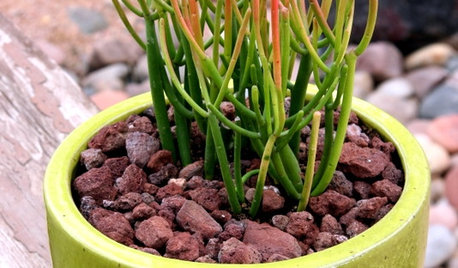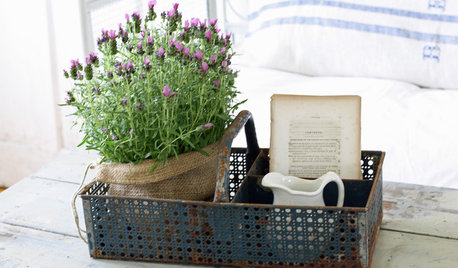repotting bb bush
Suzy11
9 years ago
Related Stories

GOLD FOLIAGEGreat Design Plant: Milk Bush
With a rubbery texture and cartoon-like branches, this succulent brings an unusual, exotic energy to landscapes and container gardens
Full Story
HOUSEPLANTS8 Essentials for Healthy Indoor Plants
Houseplants add so much to our homes — and can thrive when grown in the right conditions. Keep these tips in mind
Full Story
GARDENING GUIDESGreat Design Plant: Grow Blueberries for Their Fruit and More
Eastern gardeners should consider growing blueberry plants for their delicious fruits, bee-friendly spring blooms and brilliant fall foliage
Full Story
GARDENING GUIDESCommon Myths That May Be Hurting Your Garden
Discover the truth about fertilizer, soil, staking and more to keep your plants healthy and happy
Full Story
HOUSEPLANTSHow to Force Amaryllis Bulbs Indoors
Enjoy vibrant red blossoms even as gardens turn snowy white, by teaching this hardy repeat performer to ignore the calendar
Full Story
GARDENING GUIDES5 Best-Behaved Trees to Grace a Patio
Big enough for shade but small enough for easy care, these amiable trees mind their manners in a modest outdoor space
Full Story
HOUSEPLANTSOutsmart Winter — Make Houseplants of Your Garden Growers
No need to watch Jack Frost play Wreck the Rosemary. Bring your garden inside for the winter, using containers and these guidelines
Full Story
HOUSEPLANTS10 Top Plants to Grow Indoors
Brighten a room and clean the air with a houseplant that cascades artfully, stretches toward the ceiling or looks great on a wall
Full Story
HOUSEPLANTSPlay Up Some Fiddleleaf Figs for a Lively Indoor Tune
Strike a dramatic chord in a minimalist scene or a country note in a rustic setting — fiddleleaf fig plants harmonize with any style
Full Story
SUMMER GARDENINGHow to Grow Basil
Bright color, quick growth and endless uses for cooking make this summer annual a winner in the garden or a pot
Full Story





drew51 SE MI Z5b/6a
Suzy11Original Author
Related Professionals
Simi Valley Landscape Architects & Landscape Designers · Brooklyn Center Landscape Architects & Landscape Designers · Hartford Landscape Contractors · Aloha Landscape Contractors · Bridgeview Landscape Contractors · West Chicago Landscape Contractors · Fond du Lac Window Contractors · Northridge Window Contractors · Redwood City Window Contractors · San Luis Obispo Window Contractors · Channahon Fence Contractors · Homestead Fence Contractors · Northridge Fence Contractors · Parkland Fence Contractors · Goleta Fence Contractorsdrew51 SE MI Z5b/6a
Suzy11Original Author
drew51 SE MI Z5b/6a
Suzy11Original Author
drew51 SE MI Z5b/6a
Ernie
Suzy11Original Author
Ernie
Suzy11Original Author
Suzy11Original Author
Ernie
Suzy11Original Author
Ernie
Suzy11Original Author
Ernie
Suzy11Original Author
Suzy11Original Author
Suzy11Original Author
Suzy11Original Author
Suzy11Original Author
Ernie
Suzy11Original Author
Ernie
meyermike_1micha